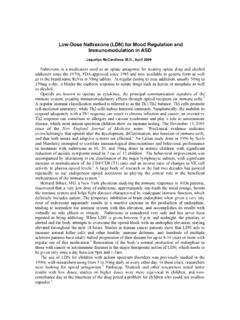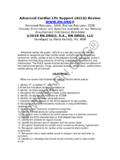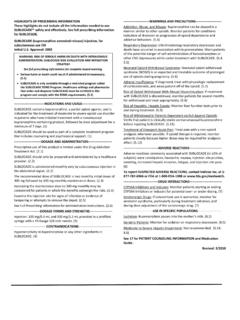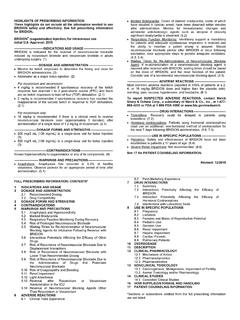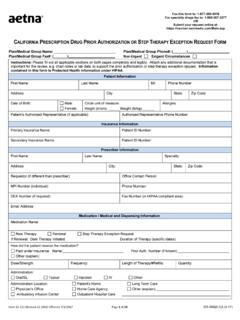Transcription of Emergency Drug Guidelines - World Health Organization
1 Emergency drug Guidelines _____ Kiribati Ministry of Health December 2007 Emergency drug Guidelines 2 Disclaimer goes here or elsewhere in the front of the booklet _____ These Guidelines have been adapted for Kiribati from the second edition of the Fiji Emergency drug Guidelines , 2007 with the kind permission of the National drug and Therapeutics Committee, Fiji. The Emergency drug Guidelines overlap with some of the conditions already covered in the other booklets particularly those in the cardiovascular, diabetes and respiratory Guidelines . Some, like the management of cardiac arrest, are treated more fully in the Emergency Guidelines but the information in each set of Guidelines is consistent. Emergency drug Guidelines were requested as a stand-alone booklet by the medical staff of Tungaru Hospital, Kiribati.
2 Emergency drug Guidelines 3 Contents Part 1 Cardiovascular Emergencies Cardiac Arrest Basic cardiac life support Advanced cardiac life support Rapid sequence intubation Cardiogenic Shock Maintain airway and breathing Optimise intravascular volume Inotropic agents Coronary Pain Syndromes Stable angina Unstable angina Myocardial infarction Cardiac Arrhythmias Causes of cardiac arrhythmias Aims of treatment Tachyarrhythmias Bradyarrhythmias Acute Pulmonary Oedema Maintain airway and give oxygen Positioning Bronchodilation Morphine Vasodilators Diuretics Inotropes Hypertensive Emergencies Part 2 Respiratory Emergencies Asthma Treatment in adults Treatment in children Exacerbation of Chronic Obstructive Airways Disease Oxygen Bronchodilators Corticosteroids Antibiotics Croup Mild croup Moderate croup Severe croup Epiglottitis Oxygen Therapy Methods of oxygen delivery Adverse effects of oxygen 3 Neurologic Emergencies Emergency drug Guidelines 4 Seizures Treatment in adults Treatment in children Migraine Treatment in adults Treatment in children Oculogyric Crisis Tetanus Airway and breathing Tetanus immune globulin Wound debridement Antibiotics Muscle spasms Acute bacterial meningitis Empirical therapy Specific therapy where the organism is known or strongly suspected 4 Poisoning and Overdose General Principles Resuscitation Gastric decontamination Supportive care Specific antidotes Psychiatric evaluation Treatment of specific poisons
3 Opitates Paracetamol Anticholinesterases Aliphatic hydrocarbons Alkali ingestion Oral anticoagulants Beta-adrenergic antagonists Iron Benzodiazepines NSAIDs Phenytoin Asprin Carbon monoxide Digoxin Barbiturates Theophylline Chloroquine Verapamil Tricyclic antidepressants Phenothiazines Lithium Ciguatera Poisoning Paraquat Poisons Information 5 Endocrine Emergencies Emergency drug Guidelines 5 Diabetic Ketoacidosis General considerations Management Special considerations in children Non-ketotic Hyperosmolar State Adrenal Insufficiency Treatment in adults Treatment in children Hypoglycaemia Thyrotoxicosis (Thyroid storm) Airways and breathing Intravenous fluids Beta-adrenergic antagonists Antithyroid drugs Hypothyroid Crisis (Myxoedema Coma)
4 Airways and breathing Intravenous fluids Corticosteriods Thyroid hormone Phaeochromocytoma 6 Fluid and Electrolyte Emergencies Hyperkalaemia Mild hyperkalaemia Moderate to severe hyperkalaemia Hypokalaemia Hypercalcaemia Hypocalcaemia Fluid resuscitation Assessing fluid deficits Selection of replacement fluid Reassessment Hypovolaemic shock Maintenance requirements each 24 hours 7 Miscellaneous Emergencies Anaphylaxis Treatment in adults Treatment in children Pre-eclampsia Treatment of severe pre-eclampsia Septic Shock Maintain airway and breathing Optimise intravascular volume Inotropic agents Acute psychosis 8 Emergency Drugs Local anaesthetics Emergency drug Guidelines 6 Sedatives and induction agents Anticholinergics Opioid analgesics Anti-emetics Corticosteroids Anti-epileptics Anti-arrhythmics Vaughan-Williams classification system Other antiarrhythmics Anti-hypertensives Inotropic agents Diuretics Muscle relaxants Neuroleptics Anti-asthma drugs Intravenous fluids Tetanus prophalaxis Non-immune patient with tetanus prone wound Non-immune patient with clean wound Immune patient with tetanus prone wound Immune patient with clean wound Drugs used in cardiac arrest Emergency Drugs Emergency drug Guidelines 7 1 Cardiovascular Emergencies Cardiac Arrest Basic cardiac life support (BCLS) Prompt and effective cardiopulmonary resuscitation (CPR) has been shown to increase survival after cardiac arrest.
5 It should be begun as early as possible after the onset of cardiac arrest and continued with as little interruption as possible until the patient either recovers spontaneous circulation or a decision is made to cease the resuscitation efforts. a. Call for help Proper CPR requires at least two people. At least one other person is required to obtain the drugs and equipment needed for advanced cardiac life support . b. Check for response Assess the patient s conscious state quickly by shaking the patient and yelling his or her name. Loss of consciousness always accompanies cardiac arrest. Unconscious patients are unable to protect their own airway. c. Airway Look in the mouth for a foreign body or vomitus. These should be removed by a finger sweep. Listen for breath sounds.
6 Noisy breath sounds are a sign of a partly obstructed airway. The absence of breath sounds may indicate complete airway obstruction. Act to protect and maintain the airway. Perform appropriate procedures including suctioning, head tilt, chin lift, jaw thrust, and insertion of an oral airway. The correct size oral airway can be estimated by holding it against the side of the patients face - it should reach from the corner of the mouth to the ear lobe. d. Breathing Look for movement of the chest wall and listen to the lungs for breath sounds on both sides of the chest. Asymmetry of breath sounds may be a sign of a pneumothorax. Act by ventilating the patient with a bag and mask. Be sure to use an appropriate size facemask that fits the patient s face. Mouth to mouth ventilation should be performed if a bag and mask are unavailable.
7 E. Circulation Feel for the carotid or femoral pulse and listen for heart sounds. (The brachial pulse is often the easier to feel in small children) If there is no palpable pulse, act by starting external cardiac massage. Cardiac massage should be performed on the lower 1/2 of the sternum, depressing it about 5 cm in adults and older children. In young children and babies it should be depressed about 1/4 of the distance between the front and the back of the chest. The rate should be 80 per minute in adults and 100 per minute in children and babies. The ratio of ventilations to compressions should be 1:5 in all ages if two people are performing resuscitation and 2:15 if one person is performing the resuscitation. Start advanced cardiac life support as soon as possible. Advanced cardiac life support (ACLS) Cardiac arrest most commonly occurs due to life-threatening arrhythmias.
8 The first step in ACLS is to determine what the cardiac rhythm is by attaching a cardiac monitor. Cardiac arrest rhythms can be divided into three basic types: Emergency Drugs Emergency drug Guidelines 8 Pulseless ventricular tachycardia or ventricular fibrillation (VF) Asystole or severe bradycardia Pulseless ventricular activity a. Pulseless ventricular tachycardia or ventricular fibrillation (VF) Ventricular tachycardia without an adequate cardiac output should be treated as for ventricular fibrillation. The most important feature of the treatment of these arrhythmias is prompt defibrillation. Defibrillation is the only treatment that has been definitely shown to increase survival after cardiac arrest - it should be performed as early as possible. The primary drug in the treatment of VF is adrenaline - all other drugs are of secondary importance.
9 Provide basic cardiac life support as described above Defibrillate with 200 J), if no response then Defibrillate with 360 J, if no response then Defibrillate with 360 J Continue external cardiac massage Establish intravenous access Secure airway and continue to ventilate with maximum oxygen available Continue external cardiac massage Give adrenaline 1 mg intravenous bolus (1 mL of 1:1000 or 10 mL of 1: 10 000) If still no response: Continue external cardiac massage Defibrillate at 360 J three times in succession If still no response: Continue external cardiac massage Give adrenaline 1 mg intravenous bolus (1 mL of 1:1000 or 10 mL of 1: 10 000) If still no response: Continue external cardiac massage Defibrillate at 360 J three times in succession If no response has been achieved at this point, the chances of recovery are slight.
10 Acidosis will certainly have occurred and may be treated with Give sodium bicarbonate (1 mmo per ml) 1 mmol per kg intravenously over 5-15 minutes Early administration of sodium bicarbonate is indicated in cases where arrhythmia is secondary to hyperkalemia, severe acidosis ( due to renal failure) and overdose of tricyclic antidepressants. Control of rhythm may be attempted with: Lignocaine 1%, 75-100 mg intravenously over 1-2 minutes followed by 4 mg per minute for the next hour and decreasing to a maintenance dose of 1-2 mg per minute thereafter If patient is unresponsive or if Lignocaine is contraindicated: Give high dose adrenaline, 5 mg intravenous bolus NOTES: If there is no spontaneous circulation 20 minutes after cardiac arrest then the chance of recovery is essentially zero.











